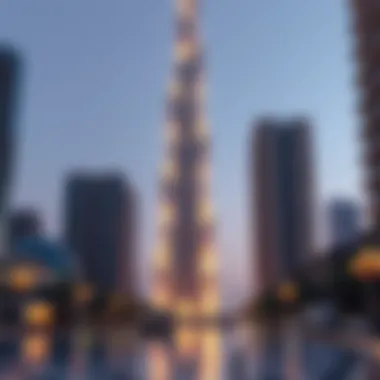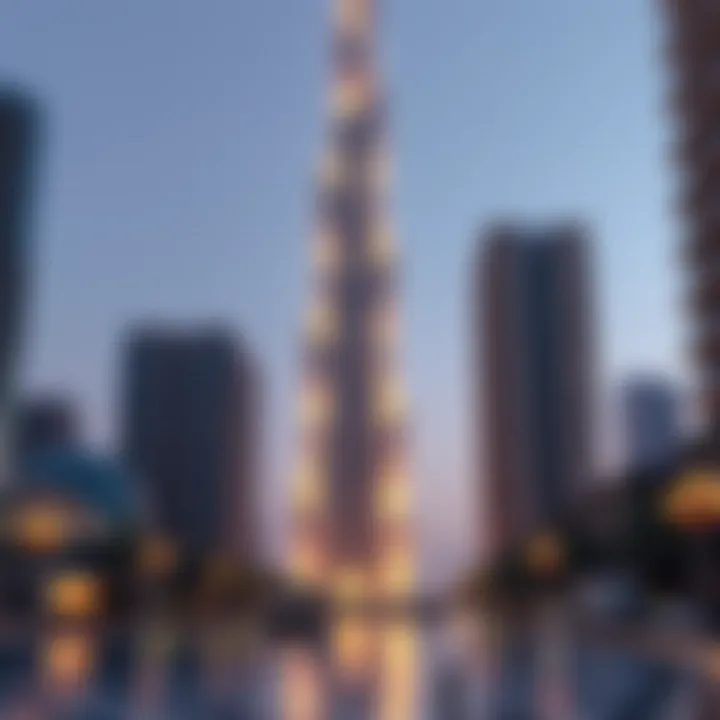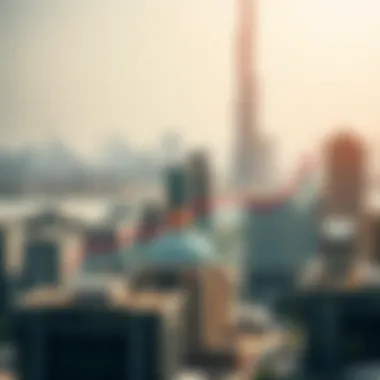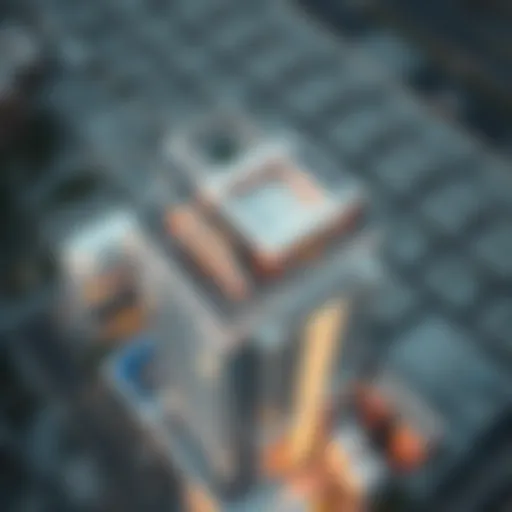Halt of Dubai Creek Tower: Effects on Urban Development


Intro
The recent decision to pause the Dubai Creek Tower project has become a hot topic in the real estate and urban development circles. This ambitious undertaking was intended to redefine the skyline of Dubai, becoming a symbol of architectural innovation and economic prosperity. Yet, with its halt, numerous intricacies come to light, forcing investors, buyers, and market analysts to rethink their strategies amid this evolving situation.
To understand the implications of such a decision, one must take a closer look beyond the surface. The halt does not only impact the project itself; it resonates through the veins of the local economy, influencing markets, investor sentiments, and urban development directions. This article aims to shed light on the challenges at play, scrutinize market trends, and explore the opportunities that might still exist in this uncertain landscape.
Prologue to Dubai Creek Tower
The Dubai Creek Tower is a highly ambitious architectural undertaking, poised to redefine the city’s already spectacular skyline. Designed to surpass the heights of the Burj Khalifa, this monumental structure aims to enhance Dubai’s global reputation as a hub of innovation and luxury. As the world looks to Dubai for architectural breakthroughs, the significance of this project extends beyond mere aesthetics. It embodies the spirit of progress that drives the emirate’s urban development efforts.
Significance in Dubai’s Skyline
With its elegant design and towering height, the Dubai Creek Tower represents a bold statement in the evolving narrative of Dubai's skyline. This architectural marvel is not just another building; it is a symbol of aspiration and success. The tower was envisioned to stand as a beacon of tourism and commerce, attracting millions of visitors and investors alike.
- Enhanced Visibility: Its unique shape ensures that it will be visible from various angles, capturing the attention of tourists and locals.
- Tourism Catalyst: A well-planned array of restaurants, observation decks, and retail outlets at its base means increased foot traffic and economic activity in the surrounding area.
- Urban Cohesion: It aims to integrate with adjacent developments, promoting a sense of community and accessibility in the heart of Dubai.
The fallout from the decision to halt construction raises critical questions about how the city will manage its architectural ambitions moving forward.
Original Vision and Design
The original vision for the Dubai Creek Tower was grandiose, aiming to blend cultural identity with cutting-edge technology. Designed by renowned architect Santiago Calatrava, the tower's structure draws inspiration from traditional minarets and the lily flower, symbolizing growth and unity. Its base was meant to host cultural exhibitions, while the apex was designed to offer sweeping views of the Dubai skyline and beyond.
- Sustainability: Key design elements included eco-friendly materials and the ability to harness natural resources, setting a standard for future constructions in the region.
- Cultural Significance: The design sought to reflect Dubai’s rich heritage while embracing modernity, making it a landmark not only in size but also in meaning.
Understanding the initial vision for Dubai Creek Tower provides crucial insight into the implications of its current halt. The challenges faced reflect broader issues in urban development and stakeholder commitment, thus impacting the hope that surrounds such landmark projects.
Current Status of the Project
The current status of the Dubai Creek Tower project provides an essential lens through which to view its broader implications. As developments unfold, understanding this status becomes critical not only for local stakeholders but also for international investors and analysts trying to gauge the health of the real estate market in one of the world’s most dynamic cities.
Announcement of Suspension
When the announcement regarding the suspension of the Dubai Creek Tower project hit the airwaves, it sent shockwaves through various circles. Investors who had banked considerable amounts of capital began scrambling for answers to questions that loomed like dark rain clouds over their heads. It was not just a mere delay; it was a signal of underlying issues at play.
The suspension raised eyebrows among real estate insiders who are well aware that major projects in Dubai often set the tone for future developments. The decision to pause construction was unexpected by many, especially in a city synonymous with ambition and rapid development. It forces one to ponder: what does this mean for the future of urban development in Dubai?
Analysts have pointed out that a project of this scale being suspended may act as a bellwether, indicating potential shifts within the city’s construction framework and real estate landscape. It’s more than just a structural halt; it reflects deeper economic factors and challenges, creating an environment of uncertainty that can deter potential investors.
"The suspension of the Dubai Creek Tower is not only about this one project but also about the shifting tides in Dubai's real estate market."
Statements from Developers
In the aftermath of the suspension announcement, statements from the developers of the Dubai Creek Tower project were closely monitored. The developers’ communication shed light on their perspective and intentions moving forward. Initially vague, these statements hinted at complexities involving funding and regulatory challenges that they faced. Developers are well aware that transparency is essential to maintain investor confidence in such turbulent times.
Highlighting this, a spokesperson for the development team articulated that the halt was a strategic choice. “We are re-evaluating our approach to ensure that this project not only meets financial expectations but also aligns with Dubai's evolving vision for sustainable urban development,” they mentioned.
This suggests that the developers are not simply putting the project on ice but are instead engaging in a thoughtful reassessment. They are trying to navigate through the tangled web of challenges with their eyes fixed on long-term viability.
For investors and market analysts, these statements serve as a crucial barometer. They indicate whether developers are committed to resuming construction or if the situation could lead to a more permanent halt. In an environment where trust is currency, timely and transparent communication can make all the difference. The confidence investors have in the project's future may hinge on the clarity and decisiveness of developer statements moving forward.


Reasons for Project Halt
The halt of the Dubai Creek Tower project is not just a setback; it's a confluence of multiple factors that reflect broader concerns in today's construction climate. Understanding the reasons for this suspension is crucial, as they can provide insight into the intricacies of the Dubai real estate market. This section dissects key elements that led to the project’s standstill, offering clarity for investors, analysts, and buyers alike.
Economic Factors Impacting Construction
The economic landscape has a significant impact on construction projects, particularly in a high-stakes market like Dubai. Moreover, the rising costs of materials and labor in recent years have made it increasingly challenging for developers to stick to their budgets. Inflation, a global concern, affects everything from steel to concrete prices. This volatility forces real estate moguls to reassess whether pushing forward with high-profile projects is financially feasible.
Changes in global oil prices also play a significant role. The UAE's economy is heavily reliant on oil revenues. A drop in these prices can create a ripple effect on funding for infrastructure projects, leading to budget cuts or, worse, project suspensions.
Ultimately, these economic factors mean that even ambitious projects like the Dubai Creek Tower can’t escape the tightening fist of financial realities.
Regulatory Challenges
Navigating the regulatory landscape can often feel like walking through a minefield. Developers must comply with a myriad of laws, zoning regulations, and permits, which can be more complicated than it may seem at first glance. In the case of the Dubai Creek Tower, the halt may well be a product of ongoing regulatory reviews that seek to ensure compliance with environmental laws or urban planning guidelines.
Delays in securing the necessary approvals can stall projects for weeks, if not months. Moreover, the climate surrounding construction regulations is dynamic. Any changes in government policies could impact the way projects are carried out, leading to uncertainty among investors and developers. As complex as it can be, embracing these regulations is essential for sustainable urban development.
Environmental Considerations
Not forgeting environmental concerns, they have become a cornerstone in discussions around construction projects. Developers are increasingly scrutinized for their impact on natural resources, local ecosystems, and carbon footprints. The Dubai Creek Tower, while an architectural marvel, must align with sustainability standards that are gaining traction both locally and globally.
Aspects such as energy efficiency, waste management, and ecosystem preservation are considered fundamental in today’s development projects. If the Dubai Creek Tower project fell short in any of these areas, it might face substantial delays or even halting as teams regroup to ensure compliance.
In summary, the reasons for halting the Dubai Creek Tower project are multifaceted, weaving through economic strife, regulatory hurdles, and environmental responsibilities. Unpacking these elements offers stakeholders not just a view of what led to this point but a lens into the complexities that future projects will undoubtedly face. Understanding these reasons is vital for any investor aiming to navigate the murky waters of Dubai's real estate market.
Implications for Investors
The halt of the Dubai Creek Tower project creates ripples throughout the investment landscape, not just within Dubai but also affecting international markets. Investors must grasp the nuances of these implications to navigate the evolving scenario effectively. Key considerations center on potential shifts in capital flows, shifts in investor sentiment, and how various economic factors may either hinder or propel future opportunities.
Effects on Investor Confidence
When a large-scale project like the Dubai Creek Tower faces suspension, investor confidence takes a hit. Investors frequently interpret such halts as a signal of underlying issues, potentially questioning the broader stability of the market in Dubai. Unfavorable news can send shockwaves, leading to a knee-jerk reaction where investors might withdraw, seeking safer havens for their capital.
The connection between investor confidence and project viability is paramount. A decline in sentiment may manifest in several tangible ways:
- Reducing New Investments: Hesitation from potential investors can lead to a slowdown in capital inflow, significantly impacting ongoing and new projects.
- Decreased Property Values: As uncertainty lingers, existing property sales may see a downturn, translating into lowered valuations and affecting returns for current investors.
- Market Comparisons: Investors will compare Dubai’s recovery with that of other global markets. If alternatives show stability and growth, it might rally support in other regions, sidelining Dubai.
"Investor confidence is the lifeblood of any market. A project’s perceived stability often dictates the flow of investment, and in Dubai, the stakes are significantly high due to its rapid urbanization and global positioning."
Potential Impact on Future Investments
The landscape of future investments in Dubai will likely be molded by the ramifications of this halt. As stakeholders assess their positions, significant trends may emerge:
- Risk Assessment Reevaluation: Investors are inclined to recalibrate their risk profiles, focusing on projects that exhibit clearer paths to execution. Transparency and feasibility will take precedence over grandeur.
- Diversification: With concern over the success rate of mega projects, investors might consider diversifying into smaller, more controllable developments, shifting away from large-scale investments that appear risky at this juncture.
- Sustainable Practices: The discourse surrounding environmental impact means investors may favor projects that prioritize sustainability, as these likely promise resilience against potential regulatory challenges.
Explore more about the dynamics of the real estate market in Dubai on Wikipedia and Britannica.
Broader Context of Urban Development
The halt of the Dubai Creek Tower project resonates well beyond the confines of a single skyscraper; it encapsulates the broader shifts in urban development across Dubai and the wider region. This section delves into the complexities shaping the real estate landscape and offers insights into the interconnectedness of various elements influencing urban progression.


Trends in Dubai's Real Estate Market
Recently, Dubai’s real estate market has shown some notable trends. In light of the halted project, some investors are beginning to rethink their strategies. There is a noticeable inclination towards sustainable investments that promise not just short-term gains but long-term value. The focus has shifted as developers might want to chase projects that align more closely with sustainability goals rather than sheer height or luxury.
Moreover, the rise of mixed-use developments has begun to dominate market discussions. Investors are looking for projects that provide both residential and commercial opportunities. This diversification seems to be the name of the game, especially when considering consumer preferences are changing. People want spaces that offer a blend of living, working, and leisure.
Additionally, the recent economic factors — such as inflation and shifting geopolitical dynamics — have churned up uncertainty. Even seasoned investors are feeling the pinch and are cautious about pouring money into projects without clear prospects.
Architectural Ambition in the Region
The architectural ambitions in the Middle East have always been audacious. However, the halt on Dubai Creek Tower could signal a necessary recalibration in how these lofty dreams are pursued. While sky-high buildings symbolize progress, the conversation is increasingly leaning toward human-centric design.
These days, there’s an emphasis on creating spaces that nurture community and enhance the quality of life for residents. Developers are now asked to integrate existing neighborhoods and respect local culture while innovating. Architectural designs that once thrived on impacting the skyline are now being asked to justify their existence through social value.
In this new landscape, less can be more. Projects prioritizing eco-friendly construction methods, effective public transport links, and the incorporation of green spaces are gaining traction. Not only do such developments contribute positively to the community but they also present a more humane approach to urbanization.
As the focus shifts, so does investor sentiment. Individuals and groups are looking for projects that align with these evolving architectural narratives. The next significant wave of development might not just be about what towers above the ground, but about what enhances life down here on the ground.
In summary, the implications of halting Dubai Creek Tower extend far and wide, framing broader conversations in the realm of urban development. Investors, developers, and city planners are now presented with an opportunity to reconsider priorities that not only champion architectural ambition but also balance it with sustainability and community integration.
Comparative Analysis with Other Projects
The consideration of comparative analysis with existing projects holds great significance in understanding the implications tied to the halt on the Dubai Creek Tower. In this ever-evolving landscape of urban development, assessing successes and failures of other ventures delivers insights that can guide future decisions for stakeholders involved in similar initiatives. The process of comparison not only reflects the current market dynamics but also surfaces unique strategies that can significantly influence investor confidence and the trajectory of real estate investments in Dubai.
Success Stories in Dubai's Development
Dubai's skyline is a testament to bold architectural endeavors, with several notable projects achieving remarkable success. The Burj Khalifa stands as an emblem of engineering excellence, drawing global attention and tourism. Completed in 2010, it reshaped the world’s perception of skyscrapers. This example underscores how visionary projects can stimulate local economies and elevate property values in their vicinity.
Another significant project is the Palm Jumeirah, an ambitious endeavor that merged innovation with luxury. Designed to maximize waterfront living and tourism, it became a prime location for residential and commercial properties. Potential investors often look at these successful projects to gauge the viability of future developments. They demonstrate the potential for substantial returns when combining innovative designs with practical considerations, such as environmental impact and market demand.
"Analyzing success stories provides invaluable lessons about resilience and adapting to an ever-changing real estate landscape."
Lessons from Failed Undertakings
Not all projects in Dubai's extensive portfolio have been successful. Some high-profile failures serve as cautionary tales. The Dubai Marina Mall expansion faced significant challenges that delayed its completion. Accumulated debts, regulatory hurdles, and market fluctuations culminated in a project that did not meet its initial optimistic rollout expectations. Investors saw their confidence wane, underscoring the complexities involved in urban projects.
Another notable example is the unfinished projects in the Dubai Land area. Initiatives like the Universal Studios Dubai theme park had grand ambitions but got stalled due to economic downturns and investor fatigue. These lessons suggest that economic viability and proper project management are crucial in determining the fate of large-scale developments.
By looking into these past undertakings, stakeholders can discern the differences in planning and execution that lead to either success or failure. Such analyses underscore the importance of thorough market research and flexibility in approach, especially in a fast-paced environment like Dubai.
Understanding the intricate dynamics at play in both successes and failures can better equip investors and developers to navigate the uncertain waters surrounding the Dubai Creek Tower project and foster a resilient urban landscape.
Future Outlook for Dubai Creek Tower
The future of the Dubai Creek Tower is particularly significant within the broader discourse surrounding urban development in Dubai. As stakeholders attempt to navigate a complex interplay of economic, environmental, and social factors, the prospects tied to this ambitious project merit thorough examination. With rising investor scrutiny and the global competition for architectural splendor, understanding potential revitalization and long-term urban strategies will shape both local and international responses to this landmark initiative.
Prospects of Revitalization
The prospects for revitalization of the Dubai Creek Tower are hinged upon several interconnected factors that could foster its eventual completion. First and foremost, the renewed interest from potential investors could serve as a catalysts. If investors see a glimmer of opportunity amid the current challenges, they may come forward with fresh capital, significantly boosting financial viability. Furthermore, government backing might play a crucial role; should local authorities decide to prioritize the project, it could be bolstered by public funds and incentives.
Moreover, the recent conversations around making projects more sustainable can provide a fertile ground for green technology initiatives, which might attract environmentally-conscious investors eager to support a vision aligned with newer standards and global trends.


- Collaborative Opportunities: Forming partnerships with innovative developers could lead to unique design elements or modern technologies that drastically enhance the tower's appeal and marketability.
- Public Sentiment: With rising awareness of urban aesthetic and cultural identity, engaging the community in discourse might result in increased local support, which can buoy the project's image.
Long-Term Vision for Urban Development
In contemplating the long-term vision for urban development, one cannot overlook the overarching ambitions that Dubai has set its sights on. The Dubai Creek Tower could emerge as a cornerstone of that vision, influencing trends in high-rise constructions and urban layouts for years to come. As the world navigates through uncertainties, Dubai aims to establish itself as a resilient model for future urban expansion built around sustainability and technological innovation.
This long-term vision includes initiatives to create a more balanced urban ecosystem, providing ample spaces for both residents and tourists. With that mindset, conceiving the tower not merely as a structure but rather a hub for activity and community engagement reinvents its purpose within Dubai's evolving cityscape.
- Smart City Integration: Integrating smart technologies across the development can ensure that the Dubai Creek Tower becomes a beacon of innovation in urban living.
- Cultural Identity: Aligning the tower’s development with cultural narratives can reinforce Dubai's unique identity, elevating its status as a tourist destination while enriching the local community’s experience.
Ultimately, the long-term vision for Dubai Creek Tower encapsulates a balance of ambition and practicality, striving for a future where architectural marvels complement the everyday lives they touch. Stakeholders must champion these aspects to galvanize support and ensure that the tower stands as a testament to Dubai’s relentless pursuit of excellence in urban design.
The vision for Dubai Creek Tower transcends engineering; it symbolizes the dynamic spirit of an ever-evolving metropolis.
Closure: A Critical Reflection
In examining the pause on the Dubai Creek Tower project, one may wonder about the rippling effects on the wider urban landscape and the myriad stakeholders invested in this grand vision. This section will delve into the crucial lessons drawn from this distinguished construction halt and the implications for future developments, framing a pathway toward more sustainable architectural practices.
Lessons Learned from the Halt
The suspension of the Dubai Creek Tower presents a valuable case study in the unknowns of large-scale real estate projects. It reminds investors and developers alike to tread carefully when ambitious visions meet reality.
- Thorough Market Assessment: One of the prominent lessons emerges from the necessity of comprehensive market analysis before embarking on colossal ventures. The surge in inflation and changing economic dynamics must be continuously monitored to ensure project feasibility. Understanding buyer sentiment and market demand is more pivotal than ever.
- Flexibility is Key: Plans crafted in steel, glass, and concrete can easily falter if they lack adaptability. As we’ve seen, shifting economic circumstances can call for adjustments in strategy. Developers may need to maintain a level of nimbleness in both design and execution.
- Collaborative Stakeholder Engagement: The importance of open dialogue cannot be overstated. All involved parties, from investors to government agencies, need a seat at the table. Transparent communication fosters trust and can preempt potential issues before they spiral into serious setbacks.
These insights stand as beacons for both seasoned players and newcomers in the real estate market, reminding them of the delicate balance between aspiration and pragmatism.
Moving Towards Sustainable Architecture
As the echoes of construction machinery quiet down, a clear opportunity arises to reflect on what it means to build not only for today but also for tomorrow. The halt of Dubai Creek Tower beckons a shift towards sustainable architecture, emphasizing environmentally conscious designs that respect both the landscape and its inhabitants.
- Emphasis on Green Materials: There is a growing demand for construction materials that serve both functionality and sustainability. Utilizing local, ethical materials can not only reduce costs but also enhance the building’s connection to its surroundings.
- Energy Efficient Designs: Innovations in energy efficiency can transform a project from merely aesthetic to revolutionary. Buildings designed with renewable energy sources can contribute significantly toward reducing overall operational costs, proving beneficial in the long term.
- Community-Centric Approaches: Urban design must consider social impact alongside financial viability. Projects that prioritize community spaces, parks, and accessibility echo a commitment to enhancing quality of life, as seen in conscientious urban planning efforts across the globe.
The transition towards a sustainable model, albeit challenging, results in architecture that is not just spectacular, but resilient and responsible.
"The future belongs to those who believe in the beauty of their dreams." — Eleanor Roosevelt.
In summary, as we reflect on the implications from the Dubai Creek Tower project, it becomes clear that these lessons and aspirations should guide the future trajectory of similar initiatives, ensuring they are not just towers of glass, but pillars of thoughtful, sustainable development.
Recommendations for Stakeholders
The suspension of the Dubai Creek Tower project signals a crucial turning point not just for the architects and builders involved, but for investors, policymakers, and buyers navigating this colossal landscape of real estate. Understanding how to react and adapt to this development is paramount.
Strategic Moves for Investors
For investors, the halt poses a unique set of challenges, yet it also opens a window for strategic recalibration. Here are some recommendations:
- Assess Portfolio Risk: Investors should take stock of their holdings in Dubai's real estate market. Assessing the potential fallout from this project’s suspension can help determine whether to divest or hold. If exposure to similar developments is high, diversifying into more stable markets may be prudent.
- Monitor Market Signals: Keeping an ear to the ground is crucial. Economic indicators like property prices, rental rates, and consumer confidence should guide investment choices. Tracking statements from the developers and government entities can provide valuable insights into potential recovery timelines.
- Explore Oppurtunities in Other Projects: With Dubai’s skyline always in flux, investors should seek alternatives. Identifying emerging developments that show potential could mitigate losses from the halted project.
"Navigating a crisis is not about avoiding risks but about managing them wisely."
Policy Suggestions for Developers
Developers play a pivotal role in shaping the future trajectory of the Dubai Creek Tower project and, by extension, urban development in Dubai as a whole. Here are key suggestions:
- Transparent Communication: Maintaining open lines to investors and the public can help retain trust. Developers should communicate regularly about challenges faced and possible solutions. This transparency reassures stakeholders that plans are in motion.
- Engage with Regulatory Bodies: Forming partnerships or dialogues with governmental agencies can ease regulatory hurdles. By addressing the concerns of these bodies, developers may create express pathways for streamlined approvals in future projects.
- Re-evaluate Project Viability: It may be necessary to revisit the drawing board to consider alterations in the project’s design or timelines. By being flexible and responsive to the evolving economic landscape, developers can pivot where needed.
- Adopt Sustainable Practices: Given the increased focus on environmental concerns, integrating sustainable building practices can enhance the attractiveness of any project. This approach not only meets regulatory requirements but also aligns with the growing demand for eco-friendly developments.
By addressing these strategic avenues, both investors and developers can encroach on the challenges posed by the halt of the Dubai Creek Tower project, transforming potential downfalls into springboards for future successes.











